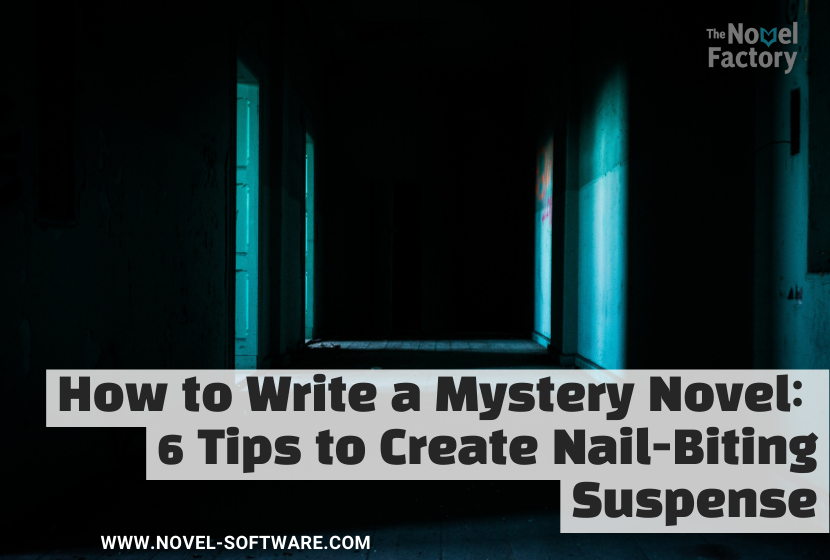
How to Write a Mystery Novel: 6 Tips to Create Nail-Biting Suspense
In this article, we’re going to explore the art of mystery novels – looking at what makes a good mystery novel and how you can create suspense that keeps your readers on the edge of their seats, and weave a conundrum that keeps them guessing…
What makes a good mystery novel?

All good novels contain some elements of tension, mystery, and surprise, but a good mystery novel follows a few unspoken rules, and you break them at your peril.
So what are the rules of the mystery genre?
If you understand these three principles, you will go far with them:
It’s a game of wits between the reader and the author

While a reader will always be drawn in by a story, and the author will keep them wanting to know what’s going to happen next, mystery novels take that to the next level.
A good mystery story is not just passive entertainment – it’s a game. The reader is actively trying to work out the solution – which is almost always who the perpetrator is.
So as a mystery writer, it’s your job to create a situation where the reader can do that guessing and to lay out just enough clues that in hindsight the answer is obvious, but not so many that the reader actually guesses it before the reveal.
It is a delicate tightrope that takes great skill to master.
The reader wins if they lose
A key thing to understand about this dynamic is that it isn’t a game where one person wins and one person loses.
If you do your job right, then you both win.
That is because while the reader may feel smug and satisfied if they do guess the perp in advance of you telling them, they will actually feel more delighted if they don’t get it more than a few moments before the reveal, but can see that it was right under their noses all the time.
If the reader guesses who the perpetrator is too early, then yes, technically they’ve won, but all suspense and thrills drain away. And this is disappointing for everyone.
The perpetrator must be under the reader’s nose

As mentioned above, a key factor of a good mystery is that the perpetrator (or other answer to the mystery) must be under the reader’s nose. Ideally, it will turn out to be a main character, but it can also be a major supporting character.
If you introduce, heaven forbid, a brand new character as the baddie at the last minute, then your reader is going to be left feeling cheated, as they never had a fair chance at guessing.
Similarly, if it’s a very minor character, then while you might be able to get away with it, it will be far less satisfying than if the character was much more prominent and still went under the radar.
Methods of achieving this often involve making the perpetrator a character so timid/weak/hopeless that it seems impossible they could ever carry out such dastardly deeds.
However, as thriller readers become more and more skilled and experienced, they will be on the lookout for this sort of trick, so mystery writers need to become ever more resourceful.
Be on the lookout for ways to make people seem harmless when secretly they are dangerous psychopaths. Techniques including:
- Having them not be who they say they are – they have changed their identity
- Having them appear physically weak – which may or may not be genuine
- Having them appear mentally simple – when actually that is a clever ruse and they are actually a genius
6 Tips for creating suspense and intrigue
1. Questions

The heart of all suspense is questions.
What’s going to happen next? Who did it? Will they escape with their lives? What is that person hiding?
Ideally, your reader will be constantly asking questions like those above, as well as ones much more specific to your story.
In a mystery or thriller, you need to keep a constant ball of questions rolling, raising new ones and answering others.
There should be some high-level questions, including the main story question, which will hang over the reader for most of the book. But there will also be smaller questions that may only be up in the air for a chapter or two.
The key is to make sure the reader always has some questions in their mind that they are hungry to know the answers to, while not being overwhelmed by too many questions. And while also continually being given some answers, in order to feel a sense of progress and satisfaction.
This is not easy, but it can be done if you’re willing to put in the effort. Here’s a technique to help with keeping track of it all.
Question analysis technique:
This technique was described by thriller writer Erin Kelly, and even (especially) if you think you’ve got your questions and answer threads woven in nicely, completing this exercise can be extremely enlightening.
Take a large piece of paper and draw a vertical line down the left-hand side from top to bottom.
Mark a dot on the line at roughly where in your story the first question is raised (so near the top of the line if it’s near the beginning, at the middle of the line if it’s near the middle, etc. This is only a rough guide, don’t worry about being exact).
Mark another dot on the line where that question is answered, then join the two lines together with a curving arc. Note next to the line what the question is.
Repeat the last two steps for all of your story questions.
When you finish, ideally you will have a lot of dots and lines evenly spaced out.
What you’re more likely to have are a bunch of dots near the beginning, a bunch of dots near the end, and a thickish curve connecting the two clusters.
Don’t believe me? Try it and see…
2. Everybody has a secret / Trust no one

A good way to keep your readers guessing is to establish the fact that nobody can be trusted and make sure everybody acts suspiciously.
Some books are fairly bullish about this and just have characters say outright that no one can be trusted. But it’s also possible to do this through more subtle means of inference and atmosphere.
When it comes to making everybody act suspiciously, if you don’t want it to come across as inauthentic then make it authentic. They should be acting suspiciously because they genuinely have something to hide. The trick is that only one of them is hiding the thing you are looking for. The others all have secrets, yes, but they turn out to be unrelated to the crime or central mystery.
Of course, you can have someone look suspicious when they are in fact completely innocent, but do this too much and it starts to feel false.
3. Master the cliffhanger

If you’re going to be a mystery writer, then you need to master the cliffhanger.
A cliffhanger is usually when something unexpected happens (a knock at the door) or a character is left in a position of peril (like, uh, hanging off the edge of a cliff).
Most people have heard of a cliffhanger, and know roughly what it means, but if you’re going to write a good one, you need to understand that every time you use a cliffhanger, you have to deliver a suitable resolution.
To borrow from Brandon Sanderson in his excellent series on writing fantasy, he puts it roughly like this:
Imagine you have a scene, where everyone is sitting around the lounge when the doorbell rings. The scene ends there, so the cliffhanger is: Who’s at the door?
You turn the page to find out.
A bad cliffhanger resolution is: it’s the pizza guy. They get the pizza and pay him and he leaves.
A good cliffhanger ending is: it was Bob’s long lost father, who he thought was dead, and he needs money. Lots of it.
Do you see the difference?
In the good cliffhanger resolution, the question is answered with something exciting which brings up more dramatic possibilities and potential for conflict.
In the bad cliffhanger resolution, the question is answered with a complete non-event. This is failing to deliver on what you promised and will leave the reader feeling disappointed.
One final thing – don’t end your novel on a cliffhanger. The contract with the reader is that you will deliver a beginning, a middle and an end. If you are writing a series or a trilogy, then it’s fine to leave some questions unanswered if they are part of the larger story arc, but you must answer the main story questions raised in a particular book. If you don’t, you haven’t delivered what you promised, and readers will not trust you enough to read future books.
Trust that readers will come back because they enjoyed your writing, don’t try to manipulate them into having to pay more just to be given the end of the story.
4. Mislead your audience

In the mystery game of cat and mouse, the author must deliberately mislead the reader, without ever actually lying.
It is normal to have an ‘obvious’ suspect, someone who is mean, cruel, and nasty. But any mystery reader worth their salt will know this person is far too obvious. However, if you’re clever, you can persuade your readers that someone else is the perfect suspect, and the reader will think they were very clever for working this out – but it turns out they were a red herring too, to distract them from the actual real perpetrator.
Likewise, there might be an object, event, or piece of information which leads to a particular conclusion – but not the right one.
Misleading your audience isn’t only about red herrings. You can also use little hints and conventions to make readers jump to conclusions which are incorrect. For example, one scene might end with a character looking at the moon, and the next scene begins with a different character also looking at the moon. From this, the reader will infer that it’s the same night without you ever actually saying so, but in fact they could be two nights ten years apart.
5. Use the ticking time bomb

Having to catch a killer is exciting.
Having to catch a killer within the next three hours before they kill their next victim… is more exciting.
Putting a ticking clock on the action is a good way to raise the tension and heighten the emotion of a mystery.
Like with your story questions, you can use a ticking time bomb on a large and on a small scale. So there may be a deadline by which the protagonist has to solve the mystery, or something terrible will happen, and you can also have much closer-in time pressures, which the main character has to deal with before the end of the chapter, or even page.
6. Foreshadow everything
It’s not that difficult to win the game of cat and mouse if you just withhold all of the important information. But that’s not really playing by the rules.
To master the game and really delight your readers, the more elements you can foreshadow, the better. The reader should be able to look back on what they’ve read and see that all the signs were there, even from the very first page.
But you must conceal these signs.
Here are a few methods for doing that:
- Distraction (something else exciting is happening at the same time)
- Sleight of hand (a false explanation for this piece of information is presented)
- By embedding key information among a lot of unimportant information, the reader thinks that’s also unimportant.
Summary
So, in summary, if you’re writing a mystery or thriller, you are playing a game with the reader, and you need to play by the rules – and make sure both you and the reader win!
Make sure you hide your perpetrator in plain sight but don’t make them obvious. Use all your skills to create suspense and tension, to keep them turning pages from the edge of their seat.
Homework Tasks
Read three of your favourite mystery or thriller novels and try to identify the techniques the author uses to create suspense and mislead you as a reader.
Further reading:
https://www.thenovelry.com/blog/suspense-writing-tips
https://www.novel-software.com/how-to-write-a-thriller/
https://www.novel-software.com/novel-outline-template/#templates (scroll down for a mystery/crime thriller plot template)
